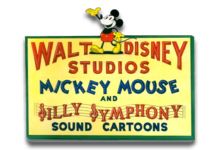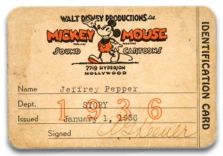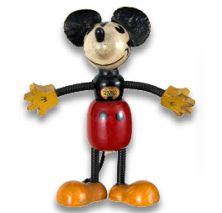Buddy suddenly remembers that he wants to check what's playing at the Vista Theatre, so he points his bicycle south off Kingswell onto Hillhurst Avenue. He travels the four blocks to the corner of Hillhurst and Hollywood Boulevard where the Vista is located.
He decides that the double bill of Tailspin and The Three Musketeers is to his liking and quickly exchanges a dime for a ticket and a few hours of vintage Hollywood escapism.
It is important to remember that at this time, the movie industry was a growing and pervasive presence in the Los Feliz and Silver Lake neighborhoods, and of course in Hollywood just to the west. Data from the 1930 U.S. Census indicates that a large number of individuals then living in these areas were associated with work within the motion picture industry.
Across the street from the Vista Theatre was one of Hollywood's then well known poverty row studios. Monogram Studios produced such B-movie fare as Boris Karloff's Mr. Wong series, The East End Kids and The Bowery Boys and was home to numerous western matinee idols such as a young John Wayne, Tex Ritter, Hoot Gibson, Buck Jones and Johnny Mack Brown.
Walt and Lillian Disney lived for a brief time very near to this location. The couple rented an apartment at 1307 North Commonwealth Avenue sometime during the mid-1920s. There is no trace left of the house or building they resided in and in fact the entire 1300 and 1400 blocks of North Commonwealth Avenue no longer exist. North Commonwealth would have intersected Sunset Drive very close to where the Monogram Studios came into being in 1931.
Today, the entire area, including the original Monogram Studio building, is part of the KCET Studios complex. KCET is the PBS affiliate for the Los Angeles area.
After watching movies and filling up on popcorn and Coca-Cola, Buddy pedals his bicycle north on Talmadge Street and eventually passes the former Vitagraph Studios that was sold to Warner Bros. in 1925.
Built in 1912, Vitagraph was one of the earliest of the Hollywood studios and enjoyed the presence of such film pioneers as Douglas Fairbanks, Lillian Gish, Rudolph Valentino, Mary Pickford, Cecil B. DeMille and D. W. Griffith. ABC Television acquired the property in 1949. Disney assumed ownership of the complex when it acquired ABC in 1996. During the time Walt was active in the Los Feliz/Silver Lake area, the studio would have been referred to as the Warner Bros. Vitagraph or the Warner Bros. Annex. It was located just a block away from Robert Disney's home.
A few blocks north, Buddy turns right on Franklin Avenue and pedals across the Shakespeare Bridge, a well known Los Feliz landmark.
Just after crossing the bridge, he turns left on St. George Street. At the intersection of St. George and Lyric Avenue, he passes two small adjacent houses that were once the homes of the Disney brothers.
Walt and Lillian resided at 2495 Lyric Avenue while Roy and his wife Edna lived next door at 2491. Both couples moved into the small homes in 1927.
The houses were built from modified prefabricated kits manufactured by the Pacific Ready Cut Homes company. Michael Barrier noted in his book The Animated Man, construction on the two homes began in August of 1926 and was completed by the following December. The cost of the land and the two kit houses was estimated by Roy Disney to be approximately $16,000.
In the summer of 1932, Walt and Lillian moved into their second home, a house they had built at 4053 Woking Way in the Los Feliz Hills. Though not on Buddy's bicycle route, the house was approximately one mile from the Hyperion Avenue studios.
Walt and Lillian lived at this location until their move to Holmby Hills in the late 1940s. This was the home where the Disney's raised daughters Diane and Sharon. It was also well known for its swimming pool that was perched precariously on a high hillside. Roy O. Disney once said, "He hung this swimming pool up on the corner of this darn thing. It's a granite hill and we were taking bets to see if it would stand."
In 1939, Walt appeared in magazine advertisements for DeSota that featured photographs taken at the Woking Way estate.
Roy and Edna Disney moved out of their Lyric Avenue home in 1934 and relocated to 4365 Forman Avenue in North Hollywood, not far from where he and Walt would build the Burbank studio at the end of that decade. Roy would ultimately live in two other homes in that same North Hollywood/Burbank area prior to his death in 1971.
Buddy rides his bike a short distance further down St. George where he passes John Marshall High School.
John Marshall High School was opened in 1930 and its tall central tower can often be seen looming in the distance in photos of the Hyperion studio. It has long been a favorite location of Hollywood filmmakers. Movies such as Raiders of the Lost Ark, Grease and more recently, Transformers have used the school as a backdrop.
Studio veteran Jack Kinney noted in his biography that he and number of other studio employees lived in apartments on Griffith Park Boulevard just a few blocks away from John Marshall. He also remembered that he and other members of the story department would sneak out of the studio to watch football games at the high school. Kinney remembered, "We were too cheap to pay twenty-five cents for a ticket in the grandstands, and we soon discovered that by climbing up an ivy-covered bank we had a first-class, close-up view of the action on the field through a chain-link fence." According to Kinney, the school's disgruntled principal ultimately turned on sprinklers to discourage the freeloading Disney employees.

Directly across from John Marshall, Buddy turns down Evans Street where after one very long extended block he arrives at Hyperion Avenue. He turns left on Hyperion Avenue. He quickly drops off some overdue books at the Hyperion Branch Station of the Los Angeles Public Library, located at 2619 Hyperion Avenue.
After leaving the library, he continues one block up Hyperion Avenue to where it intersects with Griffith Park Boulevard. He has reached the location of the Walt Disney Studios.
We have arrived at 2719 Hyperion Avenue.
During the studios' earliest of years, the area surrounding 2719 Hyperion was a generally quiet, empty place. Animation director Ben Sharpsteen remembered visiting for the first time in 1929:
"I walked through what was mainly a residential development, a section of town which had been laid out with streets and curbs, but which had very few homes at the time. It was late March and the grass and weeds were very tall and they were growing up through the sidewalk in places. It was not a street that was very much used at the time. I thought this was a very strange neighborhood for a cartoon studio, but I finally came to a main intersection as directed and I found the number on a small building next to a service station on the corner. Sure enough, the sign over the door read 'Walt Disney Studios.'"
In the decade that followed, the Hyperion studio grew, in what many observers described as an almost "organic" expansion. Existing buildings were expanded and extended; nearby buildings were absorbed and additional facilities emerged on the opposite side of Hyperion Avenue.
The Disney Annex was added to the studio sometime around 1936. During the late 1930s, it was in this place that aspiring artists were typically given tryout periods to prove their talent and skills, working mainly as in-betweeners under the watchful and often harsh supervision of studio manager George Drake. Part of the training process also involved art classes taught by Don Graham.
In less than one year following Buddy's travels on that Saturday afternoon in May 1939, the Hyperion studio would be gone. By early 1940, Walt Disney and his entire operation relocated to a sprawling new studio complex in Burbank. Buddy's Aunt Connie did not follow the company to Burbank but instead was married later in 1940 and moved to Pasadena with her new husband. Decades later, a supermarket would occupy the location, and the address, 2719 Hyperion, would cease to exist.
Buddy turns his bike around. It is getting late and he needs to get home for dinner. He pauses for a moment and looks up at the large sign on the top one of the studio buildings. He fondly remembers his birthday in 1933 when his father brought him to this place. He scans the surrounding street and confirms that he is alone except for the occasional passing cars. He shyly lifts his hand and waves. And from the sign that rises high above the address that is 2719 Hyperion Avenue, Mickey Mouse waves back.





























































































